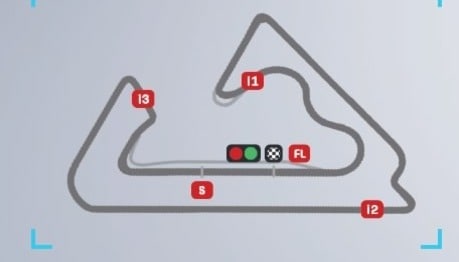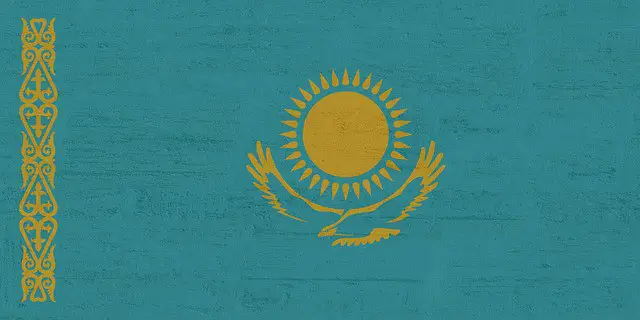The Sokol racetrack in Almaty, Kazakhstan actually didn’t take place in real life in 2023 as it was postponed until 2024 due to operational issues. But the track remains on the MotoGP 23 game, and is a great new circuit to get stuck into.

And it’s a very challenging and technical circuit as well, with tricky corners combined with elevation changes posing a unique challenge for riders.
For a bike setup, you need something that’s good under braking and leaning for sure, where you’ve got a predictable turn in to hit tricky apexes without cutting them and coming off the bike.
I ain’t gonna lie, this circuit has proved hard to get used to, but I have found a very slightly modded version of my template MotoGP setup that works OK round Sokol. Although it’s going to take a lot more practice to get good at this track.
Update – Once I returned to this track having played the game more and got used to the handling, I actually really liked it and found it addictive to ride.
Here is a MotoGP class bike setup for MotoGP 23 for Sokol:
- Suspension (Front Fork):
-
- Front pre-load – 2
- Oil Quantity – 3
- Front Spring Hardness – 4
- Front Swingarm compression – 3
- Front Swingarm extension – 3
-
- Rear Single Shock Absorber:
-
- Rear Pre-load – 4
- Swingarm connector – 3
- Rear spring hardness – 2
- Single shock absorber compression – 3
- Single shock absorber extension – 3
-
- Vehicle Geometry:
-
- Steering head inclination – 4
- Trail – 4
- Steering plate position – 3
- Rear swingarm length – 5
-
- Transmission:
-
- Gears (1-6) – 3-3-3-3-3-3
- Final ratio – 3
- Slipper clutch – 3
-
- Brakes:
-
- Front disc – 355 mm
- Rear disc – 220mm
-
- ECU
-
- Traction control – 5
- Engine braking – 4
- Anti-wheelie – 5
- Power mapping – 2
-
Recommended Race Tyres:
Hard front; Medium rear.
The ECU settings might be a little high for more advanced players, who might want to try something like 1452 or 2452. Some players also prefer using the maximum 355 mm front brake for more stopping power.
But otherwise this setup is pretty stable around Sokol, and also has a lot of the understeer you’ll find in the default game setup taken out of it.
Alternative Sokol MotoGP Class Bike Setup
I did try another setup for Sokol, that for me felt pretty similar in terms of lap time to the first setup.
Here’s an alternate bike setup for Sokol for MotoGP class:
- Suspension (Front Fork):
-
- Front pre-load – 4
- Oil Quantity – 3
- Front Spring Hardness – 3
- Front Swingarm compression – 3
- Front Swingarm extension – 3
-
- Rear Single Shock Absorber:
-
- Rear Pre-load – 2
- Swingarm connector – 3
- Rear spring hardness – 3
- Single shock absorber compression – 3
- Single shock absorber extension – 3
-
- Vehicle Geometry:
-
- Steering head inclination – 4
- Trail – 4
- Steering plate position – 2
- Rear swingarm length – 2
-
- Transmission:
-
- Gears (1-6) – 3-3-3-3-3-3
- Final ratio – 3
- Slipper clutch – 4
-
- Brakes:
-
- Front disc – 340 High mass
- Rear disc – 220 mm
-
- ECU
-
- Traction control – 5
- Engine braking – 4
- Anti-wheelie – 5
- Power mapping – 2
-
This one didn’t work as well for me, and I kept falling off using it. Setups and bike handling are highly subjective though, so test it out against the default and the first setup to see if you prefer it. It might be more because I wasn’t fully used to the track yet.
Honestly though, regardless of the setup you use, Sokol does seem to be one of the more challenging tracks that’s really hard to get right lap after lap.
Moto2 and Moto3 Class Bike Setups For Sokol
The benefit to the slower Moto2 and Moto3 class bikes is you’ve more time to react to what’s coming, which does make it easier for a technical track like Sokol with some tricky sections with successive changes of direction and blind apexes.
If you’re wanting a custom setup for these bikes, check out our generic setups page for MotoGP 23, which has starter setups for both Moto2 and Moto3 bikes that you can test against the preset setup the game gives you.
Realistically though, be prepared to put in some serious practice to master this track, regardless of which bike you’re using.
Mastering Sokol
Tips For Riding Around Sokol
This circuit is technical, undulating and tricky to get right. Here are some tips for navigating a lap around here.
Turn 1 – As soon as you pass the start-finish line on MotoGP bikes, start thinking about braking for the prolonged left hairpin of turn 1. Easy to over-run this turn. After this first hairpin, you effectively turn right away into another long looping hairpin, before you’ve two sharp right hander corners
Turn 5 – The second of the right handers after you get the looping corners out the way. It’s very tricky as it goes uphill then downhill into a blind apex. I prefer to apply the front brake in a straight line, then turn an aggressively to hit the blind apex inside kerb, and dab the rear brake to pull the bike round the corner more. It just needs practice and repetitions to get the turn in right for this one.
Turns 6/7/8 – This is the right-left-right section that leads onto the back straight. It’s probably the trickiest part of the track, but can gain you the most time if you get it right. The braking point is in between the last two poles on your right, and be sure to brake hard to scrub off a lot of speed before turning into the first right. Release the front brake, and don’t use it at all in the remainder of this chicane section or you’ll unsettle the bike. Use the rear brake only to tuck the bike into the apexes. There’s no throttle needed to move from the right to the left – just lean right over straight away. And then just the slightest dab to push the bike forward onto the sharp right that feeds you onto the back straight. Take a wide entry and use the rear brake on it’s own to turn the bike in more sharply on this right hander.
It’s the quick change of direction from the right to left bit that can catch you out here and throw you off the bike. Be sure to scrub off enough speed entering this section to keep the bike stable, and don’t use the front brake when changing direction.
Turn 9/10 – This is the double apex prolonged right hander after the back straight. Brake hard taking several goes on the front brake, and add some rear brake if needed to make the corner. And then you just have to be patient while you coast round this longer corner before you can get back on the power.
Turns 11/12/13 – The last 3 corners run in a right-right-left sequence, and take some practice to really get right. Here’s how you tackle each one:
- Turn 11 – Very sharp right hander so start braking super early for this corner (like halfway along the short straight that leads onto it), to get the the bike slowed right down. Dabbing the rear brake can help lean the bike in better for the very sharp apex.
- Turn 12 – Just a slight dab on the power out of turn 11, then lift and lean into this turn, adding some rear brake if needed. Can cut the kerb a little bit to gain time.
- Turn 13 – Another very sharp corner to finish. Slight dab on the power out of 12, then dab the front brake and lean in adding some rear brake to tuck the bike in.
Front brake – The front brake is important to get stopped after the straights, but don’t use it when leaning into the slower/sharper corners or you’ll fall off the bike. Use the front brake to generate the initial stopping power in a straight line, then release it and use the rear brake to tuck the bike into slower corners.
Rear brake – I’ve not been using the rear brake much overall on MotoGP 23 so far, but I have been using it a lot specifically at Sokol. Because of all the tricky, undulating, awkward corners here, I’ve been using this braking technique where I alternate the front and rear brake. I use the front brake to get most of the stopping done in a straight line, and then let go and dab the rear brake to get the bike leaned in more to slow corners. See here for a quick controller calibration tweak you can make to allow you to use the rear brake a little more aggressively without unsettling the bike.
Tyres – Using a soft front tyre can deliver better lap times in qualifying, but never use it for the race. In fact, going the other way and using a hard front tyre is usually recommended for races here to avoid overheating.

